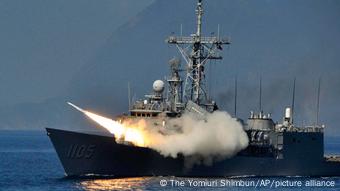
The plane carrying US House of Representatives Speaker Nancy Pelosi landed at Taiwan’s Taipei Airport on August 2. Pelosi has been a vocal critic of China for decades, while ardently supporting Beijing’s opposition, including the Tibetan Buddhist leader Dalai Lama and Hong Kong’s pro-democracy activists. “Our delegation’s visit to Taiwan demonstrates the United States’ unwavering commitment to supporting a vibrant Taiwanese democracy. Our discussions with Taiwan’s leadership reaffirm our partner’s support and advance our common interests, including advancing a free Indo-Pacific.” and open,” Pelosi wrote after landing.
Meanwhile, the media reported that Chinese and American fighter jets were heading for the island. “Pelosi’s visit to Taiwan will be gross interference in China’s internal affairs and will lead to very serious events and dire consequences,” said Chinese Foreign Ministry Spokesperson Zhao Lijian. Pelosi’s Asian tour kicked off on July 31. Visits to Malaysia, Singapore, Japan and South Korea were officially announced in the travel programme. Taiwan was not on this list, but American media reported Pelosi’s plans to visit the island. Chinese President Xi Jinping, during a telephone conversation with US President Joe Biden, warned the United States against “playing with fire” regarding Washington’s position on Taiwan.
Will the US protect Taiwan from China?
It is unclear to what extent Taiwan can count on US support in the event of Chinese aggression. For decades, Washington pursued a policy of “strategic ambiguity” toward Taiwan, maintaining friendly contacts with its government without formal diplomatic relations or even recognition as a fully sovereign state. The White House sells arms to Taipei but does not officially commit to military intervention.
Nancy Pelosi speaks at commemorative events marking the 290th anniversary of the Tiananmen Square tragedy
Meanwhile, China claims the island called the Republic of China (Taiwan) as its own and is making plans to take it back. If necessary, by force.
In recent decades, the Chinese Communist Party has actively developed its armed forces, known as the Chinese People’s Liberation Army (PLA), according to observers. The PLA dwarfs Taiwanese troops and, according to some experts, is even more powerful than the forces that its supporters, such as the United States or Japan, can bring to the region. But that doesn’t mean Taipei is completely helpless in the face of a possible attack from Beijing.
“Porcupine Strategy”: Making Invasion Expensive for China
The potential risk of a Chinese invasion has loomed over Taiwan for decades. Long enough for Taiwan to develop a sophisticated defense system suited to its geography. To deal with a giant power like China, Taiwan has adopted an asymmetric warfare known as the “porcupine strategy” that aims to make invasion too difficult and expensive for the enemy, international observers say.
Authorities accumulated large stockpiles of anti-aircraft, anti-tank, and anti-ship weapons and ammunition. This includes unmanned aerial vehicles (UAVs), mobile coastal defense cruise missiles (CLCMs) capable of destroying high-value Chinese military vessels and naval systems.
Fast stealth ships and miniature missile attack boats are other relatively inexpensive but highly effective equipment. They may be dispersed among fishing boats in Taiwan’s ports. Naval mines and fast miners can also complicate the amphibious operations of any fleet.
multilevel naval defense
To take the island quickly, the Chinese PLA will need to transport a large number of troops and a huge amount of cargo across the strait – armored vehicles, weapons, ammunition, food, medicine and fuel. This is only possible by sea, as the possibilities for air transport are limited, experts say.

Taiwanese naval exercises
The territory of Taiwan includes a chain of islands, some of which are located close to the Chinese coast. Monitoring systems installed on these islands can detect the fleet sailing off the coast of China. That should give Taiwanese forces enough time to coordinate a multi-layered defense, military analysts believe.
Naval mines combined with fast ships and missile attack boats, as well as land-based munitions placed on the coast and nearby islands, will hit the PLA at its most vulnerable before it has a chance to land and begin an operation.
Guerrilla war
Taiwan has also prepared its cities for guerrilla warfare should the PLA manage to land. In urban combat, portable air defense systems (MANPADS) and mobile systems such as High Mobility Artillery Rocket Systems (HIMARS) can be used, and buildings can be turned into fortifications.

Taiwan is ready for guerrilla warfare
According to a report released in 2017 by the RAND Foundation, Taiwan’s military reserve system has 2.5 million people and an additional one million civil defense volunteers. Altogether, that number is about 15% of Taiwan’s population, or one man in four.
Protect the defense system
One of the main goals of Taiwan’s tactics is to protect key defense systems, including aircraft and anti-missile installations, which can intercept ballistic missiles and inflict major damage on invading forces.
Over the past two years, Taiwan has acquired dozens of modern fighter jets from the United States, while also producing its own AIDC F-CK-1 Ching-Kuo fighter, dubbed the local defense fighter. Many planes are in fortified bases and pilots are trained to use the highway as a runway in case of bombing at airports.
In addition, while Washington cannot intervene in the conflict, it has promised to continue selling defense systems and intelligence support to Taiwan.
All of these measures will help Taiwan signal to China that if war starts, it will be long, expensive and bloody.
However, for a small power like Taiwan, the best case scenario would be for the conflict to never occur.
Source: DW
Anna White is a journalist at 247 News Reel, where she writes on world news and current events. She is known for her insightful analysis and compelling storytelling. Anna’s articles have been widely read and shared, earning her a reputation as a talented and respected journalist. She delivers in-depth and accurate understanding of the world’s most pressing issues.